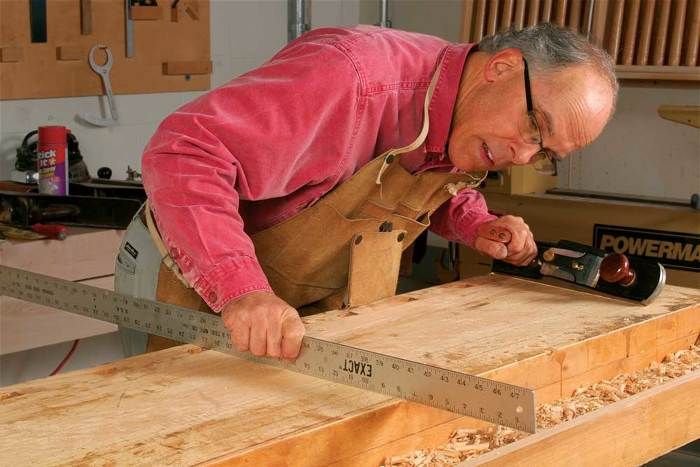
You can't do good work on a worn-out bench, so flatten the top, tighten the base, and adjust the vises
by Richard L. Humphreville
excerpted from Workbenches
Even after 30 years as a cabinetmaker, I still vividly remember the painstaking effort it took to build my first professional workbench. The finished bench was a thing of beauty, and at first I was reluctant to use it, showing it off to anyone who walked into my shop. When I did start using it, the inevitable first ding made me cringe.
But damage to a workbench is impossible to avoid. After years of hard use as a platform for sawing, planing, chiseling, hammering, pounding, gluing, and finishing, any bench, no matter how elegant, will need some careful restoration.
I’ve revived a number of war-scarred and battle-weary benches over the years. Bench designs differ, but all benefit from a flat top, rigid base, and well-tuned vises. I’ll show you how to bring back any kind of bench to the perfect working condition that befits the most important tool in your shop.
Skip the gym, and handplance instead
Use a card scraper or cabinet scraper to remove any glue, paint, or other gunk that’s built up on the top surface and edges. After the top is clean, use a pair of winding sticks to check for twist in the benchtop, marking any high spots that will need to be removed (see Fundamentals: Use Winding Sticks to Ensure Flat Stock, FWW #177). Then use a 4-ft. ruler or straightedge to see where the top has lost its flatness. Drag the ruler’s edge lengthwise, across the width, and diagonally over the entire top, highlighting all the high spots with a pencil.
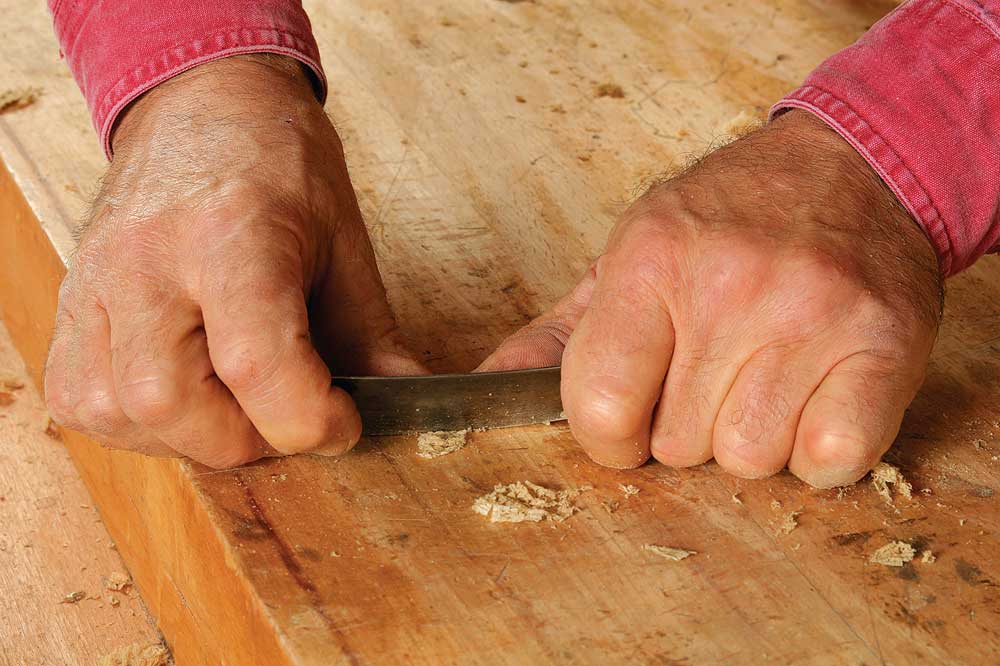
click to enlarge
Smooth the Bumps. Use a scraper to remove any dried glue or finish from the benchtop
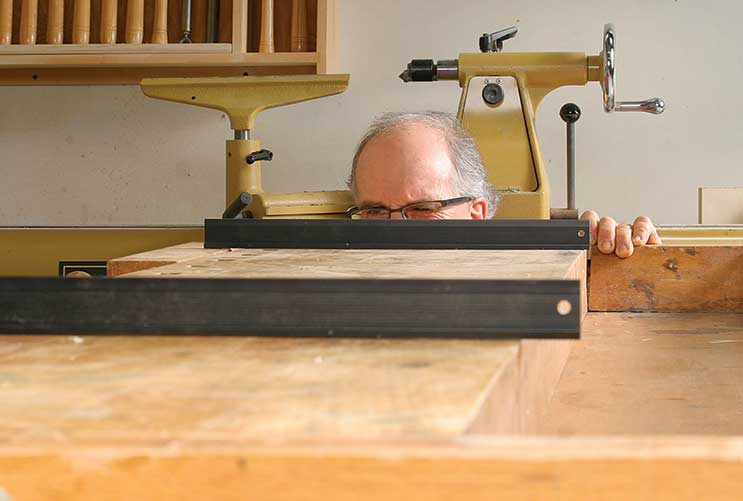
click to enlarge
Twist detective. A pair of winding sticks allows you to see if the benchtop is twisted
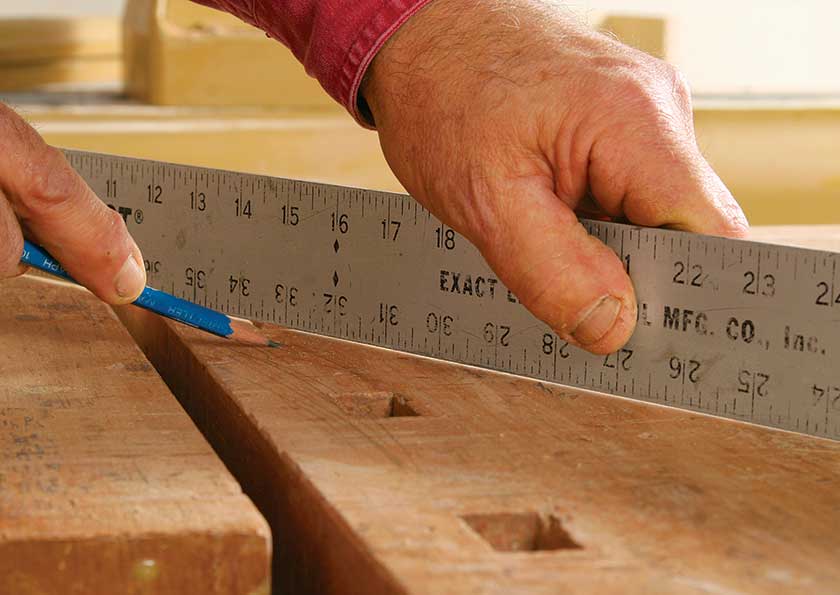
click to enlarge
Flag the high spots. Move the edge of a 4-ft. ruler across the benchtop and use a pencil to mark the high areas.
Next, take off the vises and put them aside to be tuned up later. If your bench has stabilizing battens at each end, unbolt them and clean out any sawdust buildup on both halves of the joint. Put the battens aside, too.
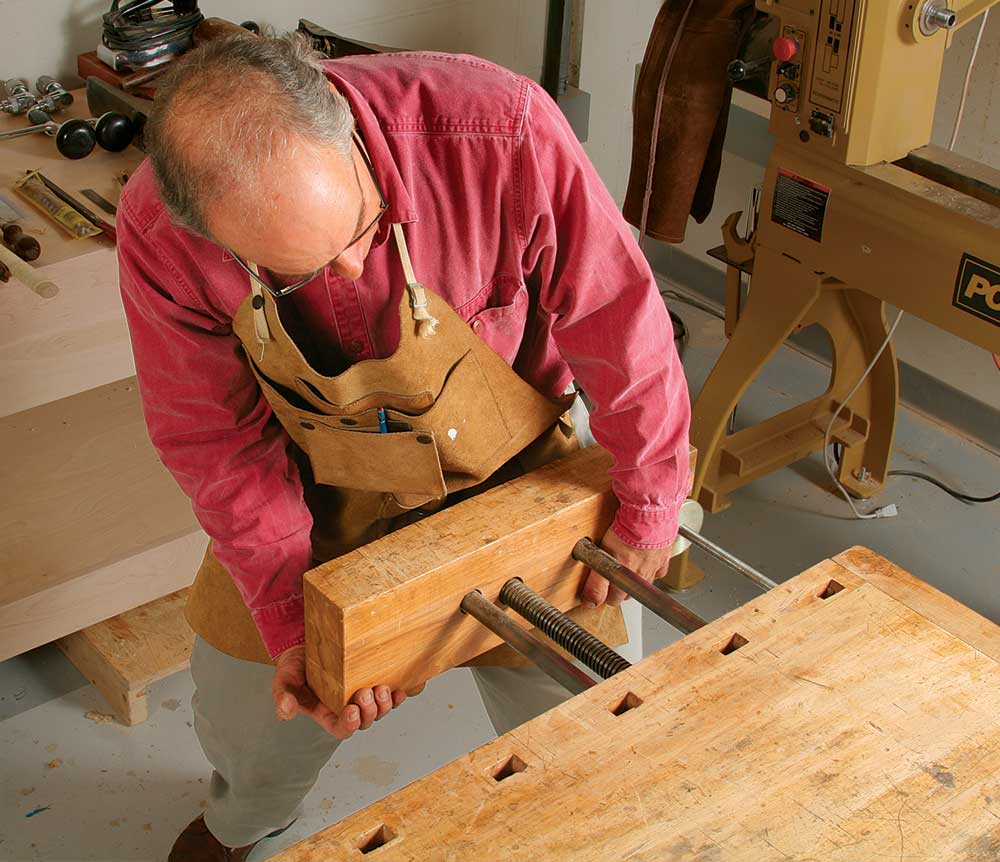
click to enlarge
Remove the vises. You’ll tune up the vises after the top has been flattened. If your bench has them, unbolt the stabilizing battens (below) and clean out any sawdust that has worked its way down between them and the benchtop.
Early in my career, I used a belt sander to flatten my bench, but it only made matters worse. Handplaning is the way to go. You’ll need a well-tuned No. 5, No. 6, or No. 7 plane, depending on the size of the workbench. A high-quality plane from Lie-Nielsen or Veritas is a major investment, but you can buy a new Stanley or Anant for $60 to $90. It is also possible to find used planes on eBay or at flea markets, or you can borrow one from a fellow woodworker. (For tips on how to tune up a plane, see Handplane Tuneup, by David Charlesworth, FWW #172). Planing the benchtop will be physically demanding and is not a task for those in poor shape. Traditionally, teenage apprentices were given the job on a cool day.
Adjust the plane to take thin shavings, which will minimize tearout and keep you from overexerting yourself. With the plane at a slight skew to the direction of travel, begin the planing sequence with passes across the width of the benchtop. Overlap the previous pass just enough to avoid leaving unplaned strips. Work the plane across the entire surface in one direction and then the other, being careful to avoid rounding over the front and rear edges of the bench surface. Making this mistake prolongs the flattening process.

click to enlarge
Bevel the edge. To prevent tearout when handplaning across the benchtop, use a block plane to create a small chamfer along the back edge.
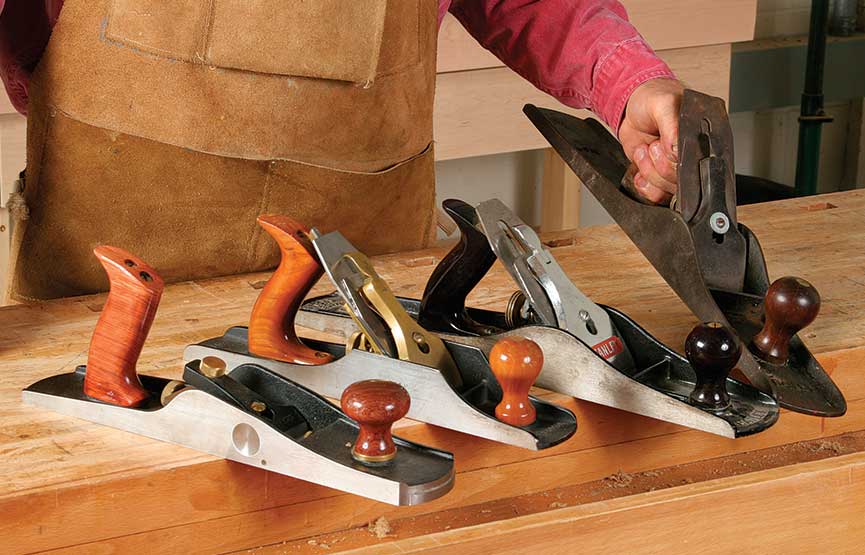
click to enlarge
Pick a number. To flatten the benchtop, you can use (from left) a No. 5 plane (bevel up or bevel down), a No. 6, or a No. 7. The plane’s length should nearly equal the width of the benchtop (excluding any tool tray).
The next sequence is to plane the surface diagonally from left to right and then right to left. Again, this process is very deliberate and must be done with care to flatten the bench surface thoroughly. Last, plane the length of the bench, switching directions if necessary to go with the grain of individual boards.
Once this sequence of planing passes is complete, check your progress with the straightedge. This time, mark the low spots with a pencil. Usually, you’ll need to plane the surface several times using this sequence before it is flat, so keep the plane blade razor-sharp and pace yourself.
Repair any holes or dents in the top
After verifying that the benchtop is flat by sweeping the straightedge over the surface in all directions, use a cabinet
scraper to remove any ridges, or tracks, left by the handplane.
Even with a flat surface, there will be gouges and holes too deep to be removed by planing. To patch deep gouges, I use a “Dutchman,” which is a piece of wood slightly deeper, wider, and longer than the gouge and of the same species and appearance as the benchtop. Lay the Dutchman over the gouge with the grain aligned, then use a marking knife to scribe a line around it. Next use a router, laminate trimmer, or chisel to remove the wood from the benchtop within the scribe lines. A pressure fit with no gaps around the edges is your goal. To make it easier to fit the Dutchman, it helps to chamfer its leading edges lightly. After gluing the Dutchman in place, use a plane to bring it flush with the benchtop.
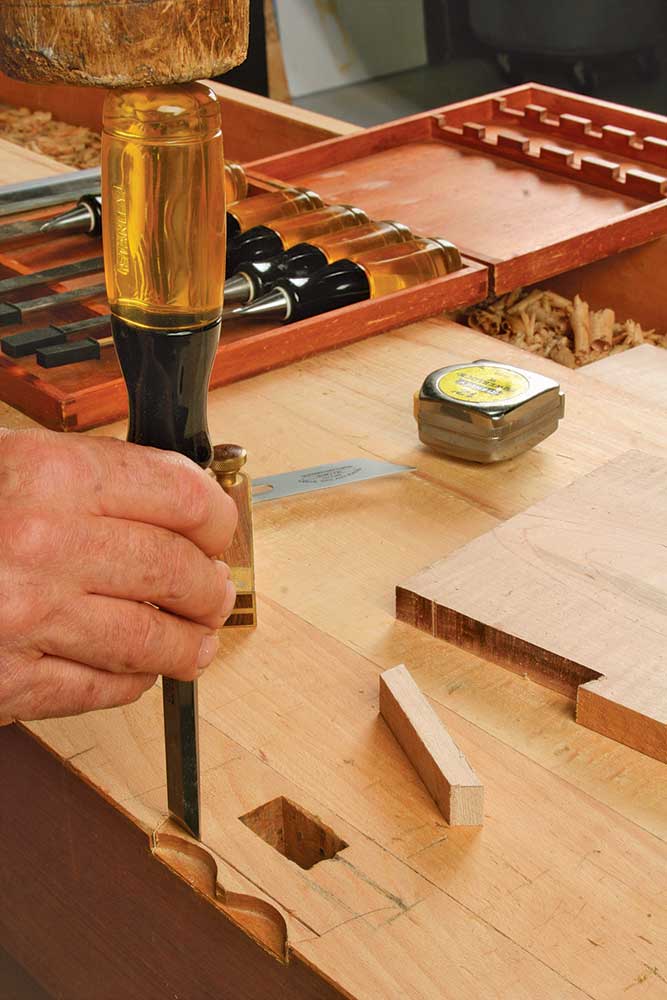
click to enlarge
A Dutchman to the rescue. Lay a piece of wood (known as a “Dutchman”) over a damaged section of the top and mark around it. Chisel out this section.
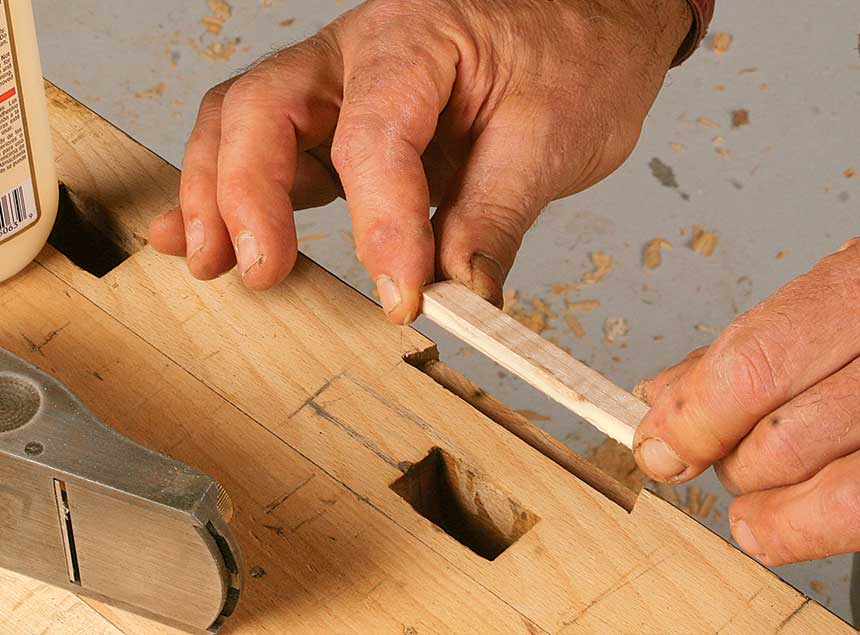
click to enlarge
Apply glue to two sides of the patch and insert it into the benchtop. The dovetail shape gives mechanical strength when patching an edge.
Smaller holes require a simpler approach. First, clean up the hole using a Forstner bit. Then cut a square peg slightly larger than the hole, taper two opposite sides at the tip, and round over the corners using a block plane. Put some glue in the hole, align the untapered edges of the peg parallel to the direction of the bench grain to prevent the bench surface from splitting, and tap in the peg. When dry, saw off the protruding part of the peg, and chisel the surface flat.
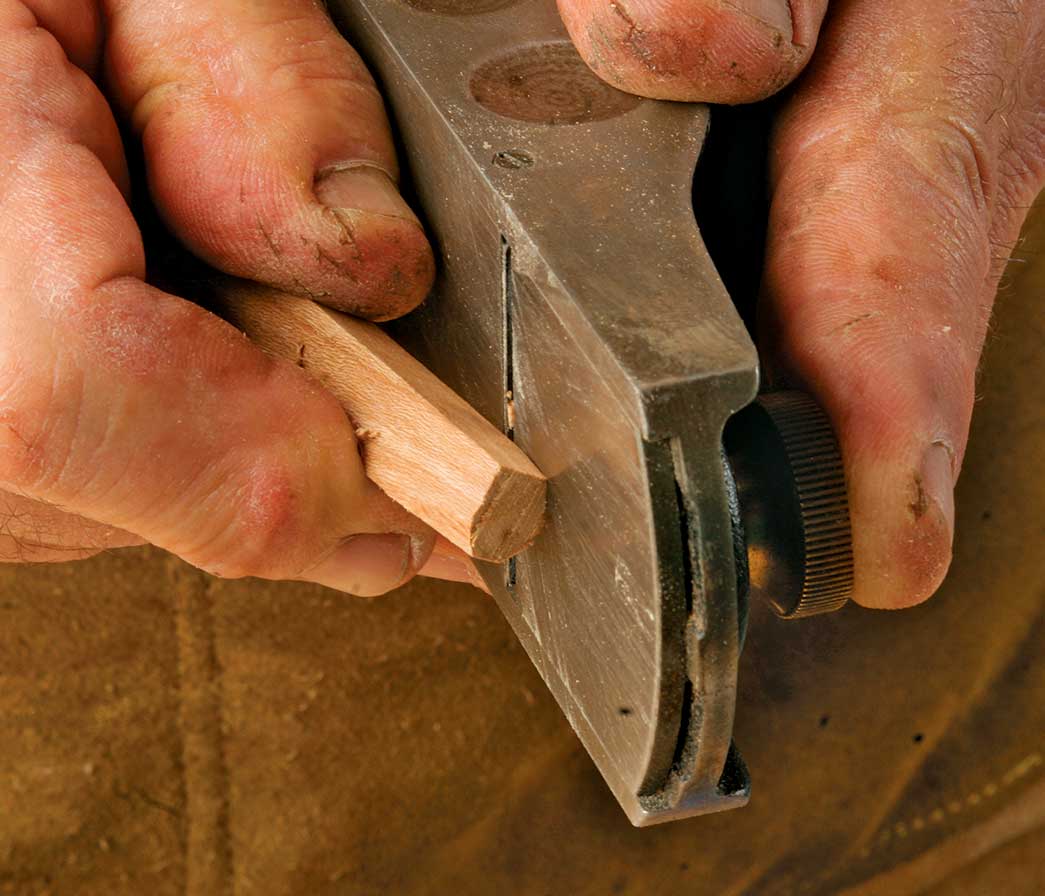
click to enlarge
Step one: After cleaning up small holes with a Forstner bit, cut a peg slightly larger than the hole. Taper two opposite sides of the peg, round its corners
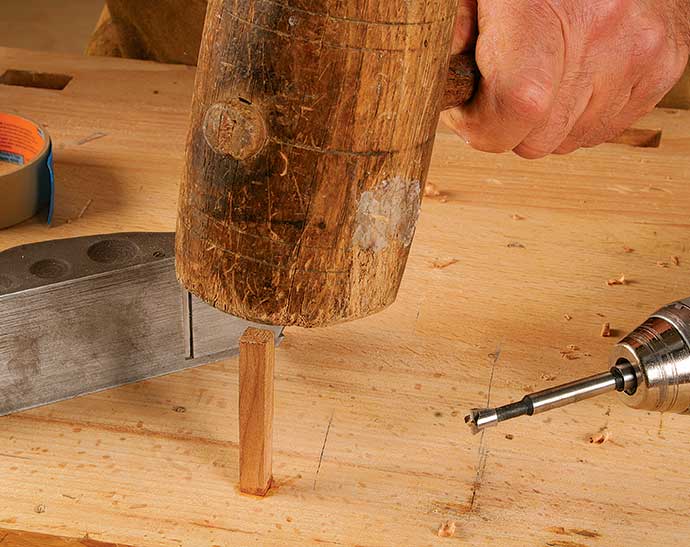
click to enlarge
Step two: Tap it into the hole.
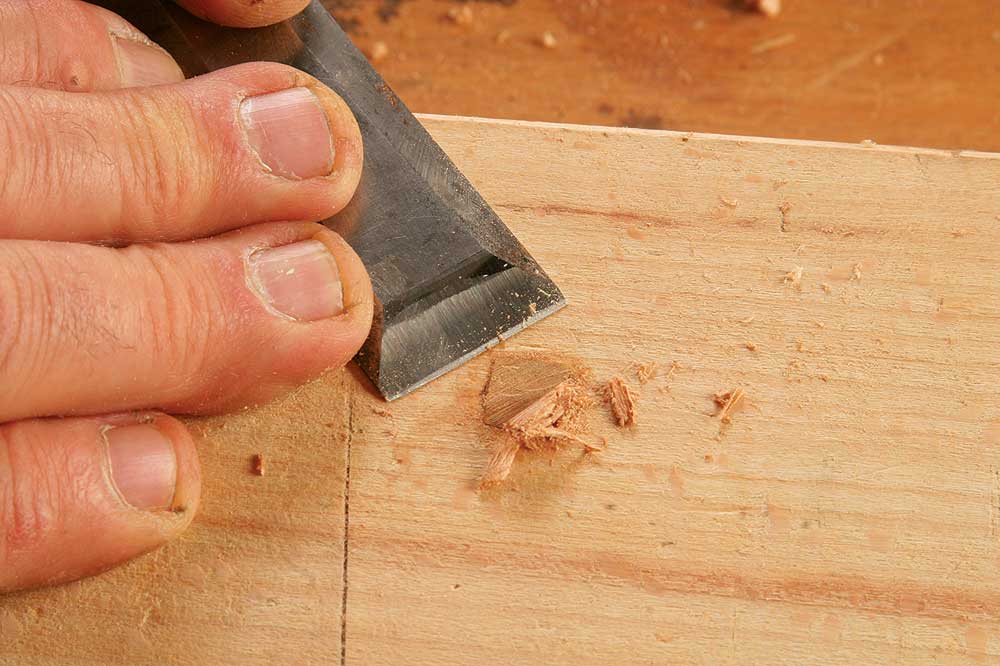
click to enlarge
Step three: When the glue has dried, trim the plug flush.
To fill shallow chipouts, mix epoxy with very fine sawdust. A loose mix with a minimum amount of sawdust is best to enable the epoxy to sink thoroughly into the affected areas. You also can add a little dye powder to help match the color of the filler to the bench.

click to enlarge
Epoxy does it. Medium-size holes can be filled with a mixture of very fine sawdust and epoxy. Frame each hole with masking tape.
Any small, shallow dents can be steamed out with the tip of an iron. Put some water in the dent, let it stand for a few minutes, and then place a wet cotton rag over the area. Apply the leading inch or two of a hot steam iron over the rag. Keep adding water to the rag as you go. Be persistent; hardwoods like maple and beech are slow to swell when steamed.
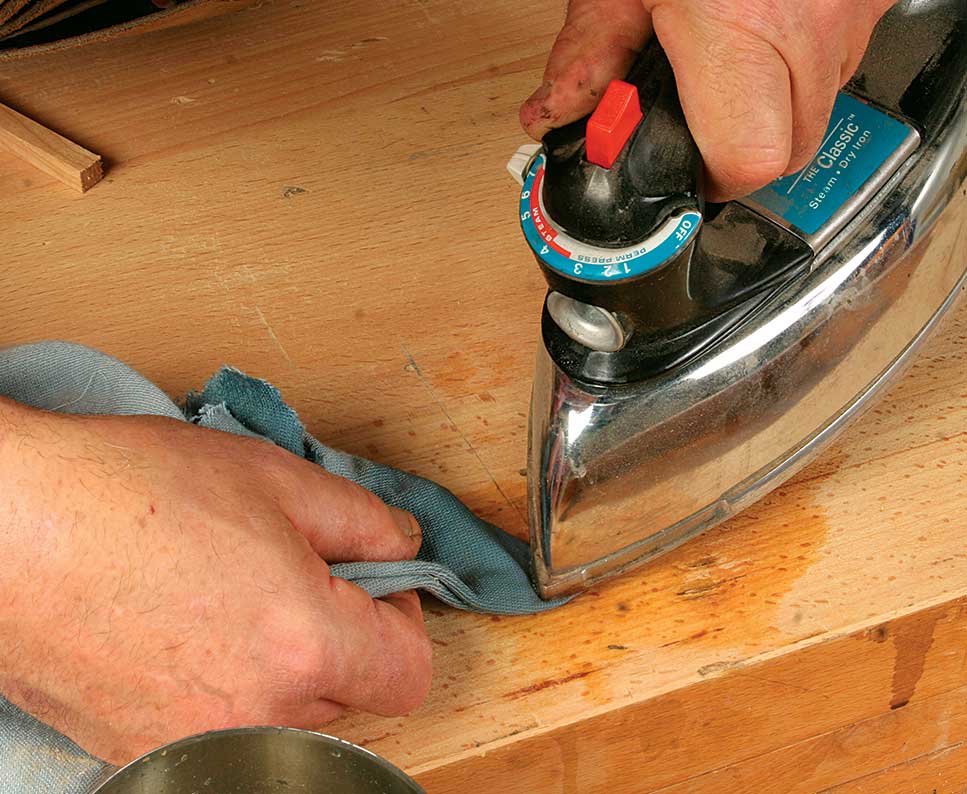
click to enlarge
A swell repair. Minor dents can be repaired by applying a hot iron to the damp wood, causing the wood to swell.
If you removed the stabilizing battens, now is the time to reattach them tight against the end grain of the benchtop and flush with the surface, scraping or planing them if needed.
Check for a sturdy and stable base
My experience has shown that a well-constructed bench retains its structural integrity. Nevertheless, a thorough check should be made, so remove the benchtop and see if the base has any joints that need regluing or bolts that need tightening. If the stretchers are bolted to the legs, tighten them. As you work, use a large T-square and take diagonal measurements to check for square.
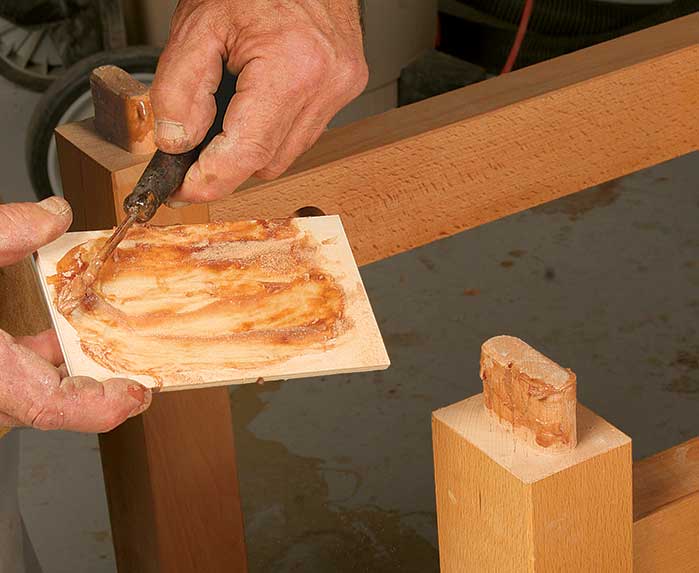
click to enlarge
Reglue loose joints. Epoxy mixed with fine sawdust makes a good gap-filling glue if joints on the base have become loose.
On my bench, the legs must have been made while the lumber had a higher moisture level than the upper rails and the feet. As a result, the tenons shrank away from the mortises. In a situation like this, scrape away as much dry glue as possible, then carve some grooves on the tenons with a chisel, which gives the epoxy a better mechanical bond with the wood. Because the epoxy will need to fill the gaps, mix in some sawdust (the same mixture used to fill dents in the benchtop). Apply the epoxy and clamp the joints, checking for square as you go.
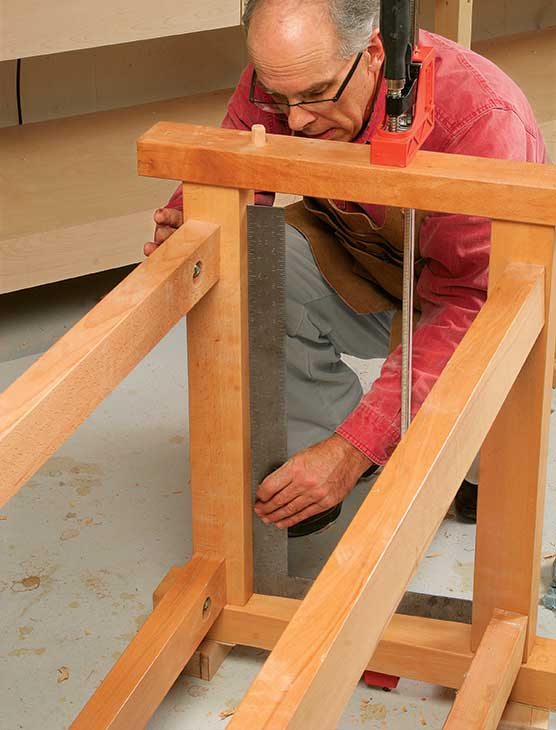
click to enlarge
Check for square. When regluing and tightening the base, make sure the structure remains square.
If your bench has wooden feet that rest on the shop floor, check them to see if they are split or worn down. If so, replace them. After removing any nails or screws, remove the old feet with a handsaw or chisel and mallet. Before attaching new ones, remove the old glue and flatten the surface where they will be attached. Hot vinegar is excellent at loosening most glues, but use a heat gun very carefully to loosen epoxy.
With the new feet glued and screwed (counterbore and bung the holes), I glue on 1⁄16-in. to 1⁄8-in.-thick rubber pads from underlay material available at carpet stores. These help balance the bench, reduce future wear, and keep the bench from sliding around the floor.
To level the benchtop, shim up the low spots where the base is attached.
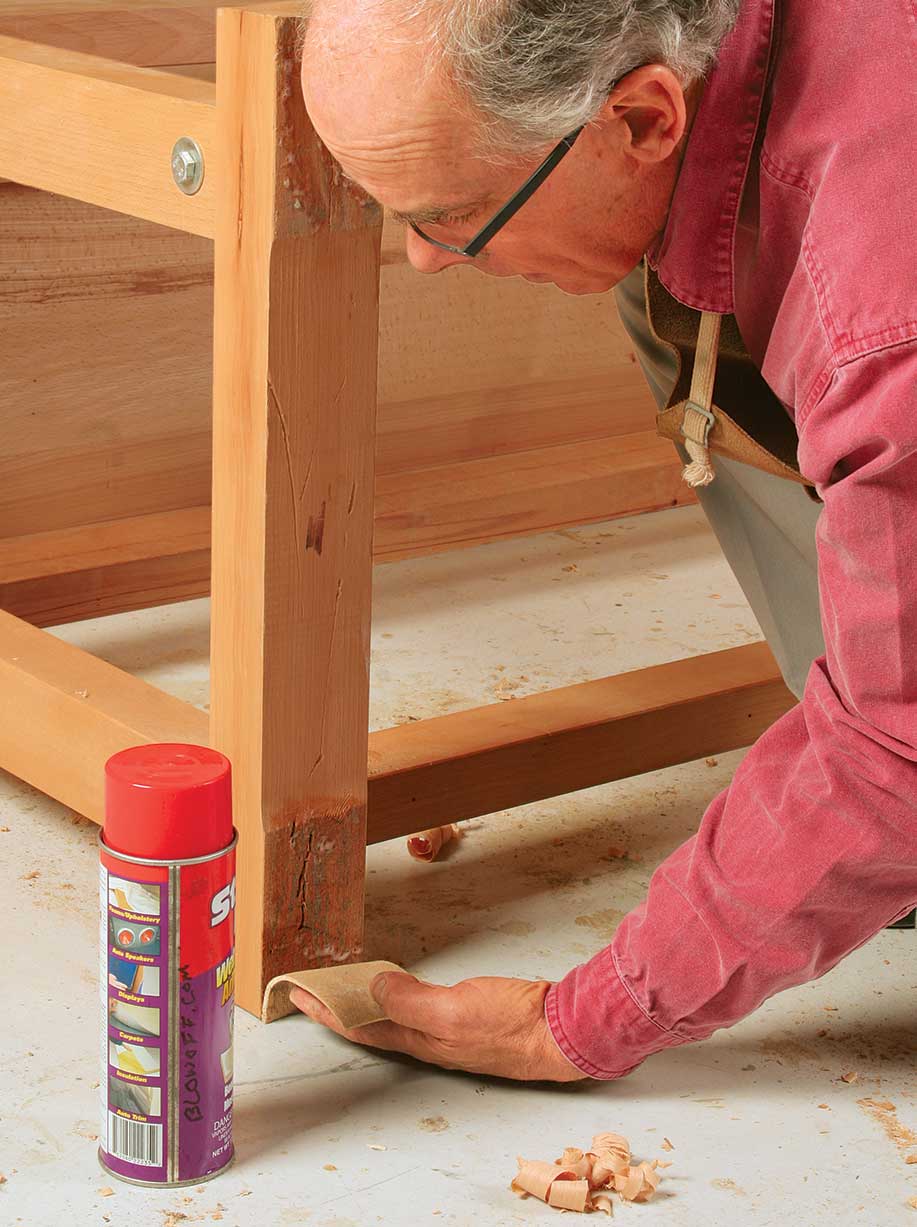
click to enlarge
Nonskid pads. Thin pieces of rubber carpet underlay glued to the bottom of the feet prevent the bench from sliding around in use.
A good vise is a virtue
With the rest of the bench finished, the next step is to clean and repair the vises. As the bench ages, the wood shrinks and expands, loosening both bolts and joints and shifting vises out of alignment.
Lubricate the guide bars and threaded rods with a spray lubricant. When you reattach a vise, alignment is critical, so use a straightedge to check that the vise is level with the benchtop and a ruler to verify that the open jaw is parallel to the bench. Keep the attachment bolts snugged up but still loose enough to tap the vise into perfect alignment before the final tightening. Replace worn-out hardwood cheeks on the inner jaws of a metal vise. Be sure the upper edges of the cheeks touch first, by a fraction of an inch, when closing the jaws.
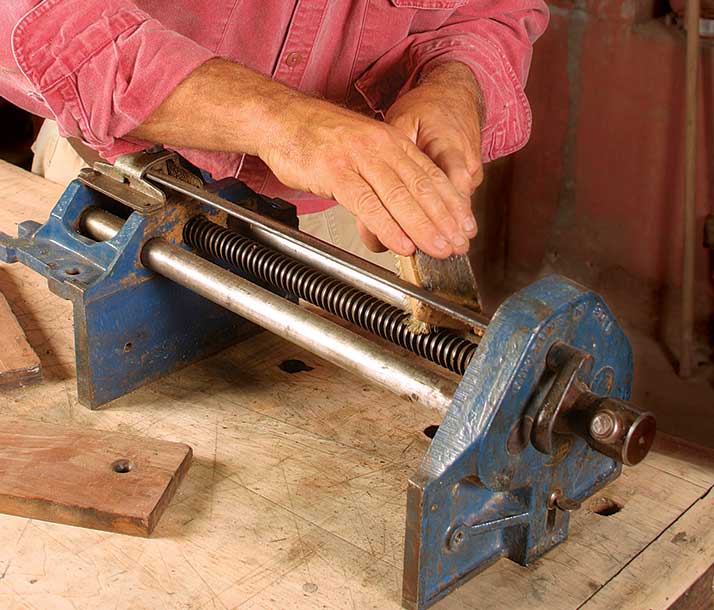
click to enlarge
Clean and fresh. To prevent sticking, clean and lubricate the guide bars and the threaded rod.
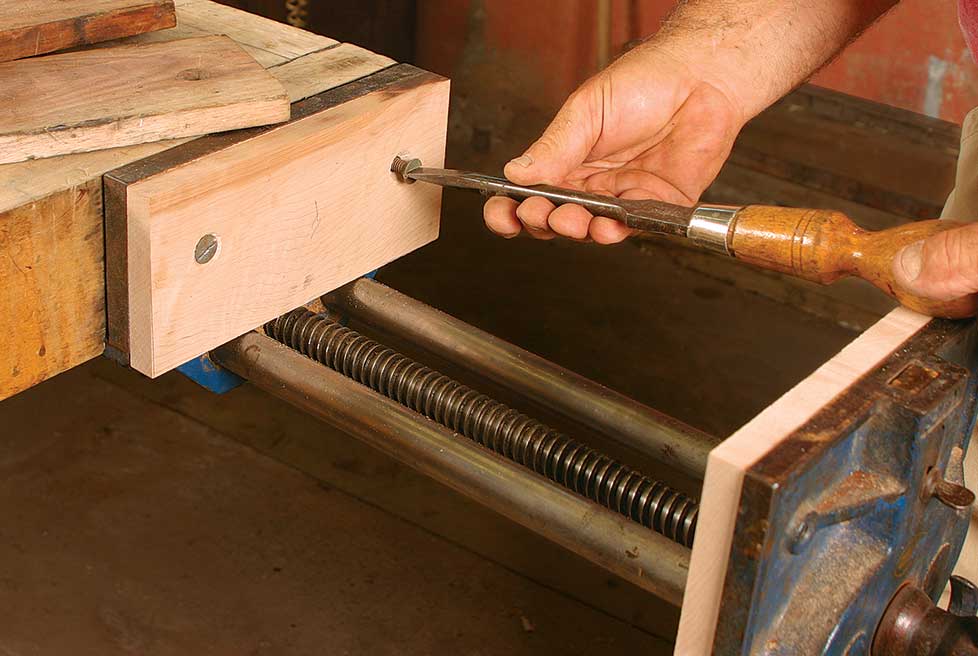
click to enlarge
Attach fresh hardwood cheeks to the jaws.
If your tail vise has adjustment screws on the guide bar, use them to align the vise flush with the benchtop. You may also need to plane joints that have become exposed due to wood shrinkage and now prevent the vise from closing completely.
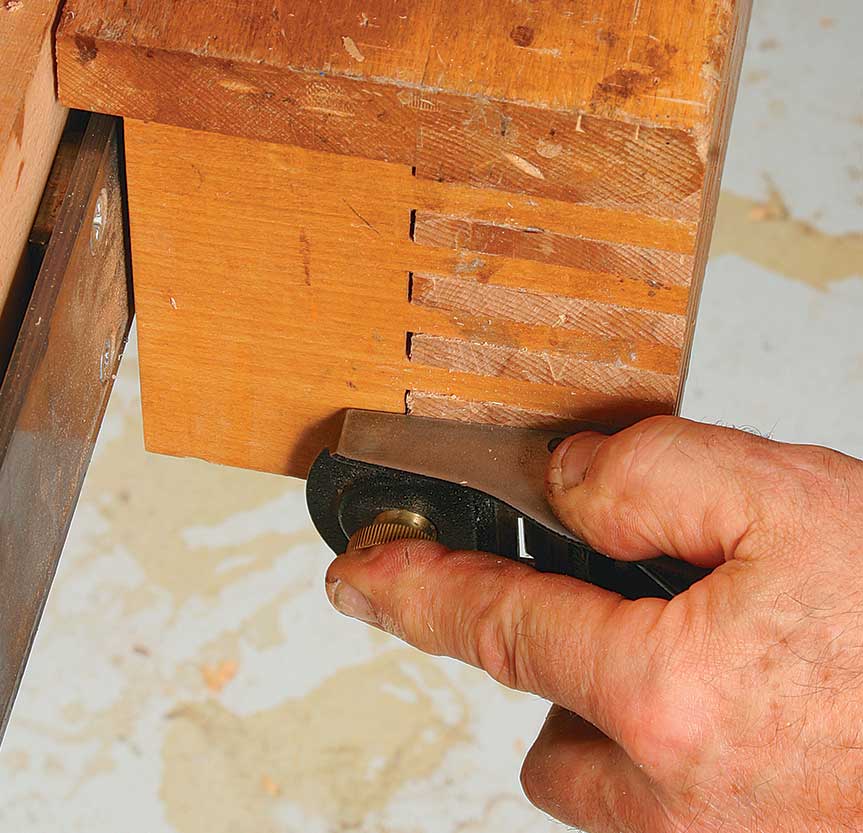
click to enlarge
On the level. If joints have become proud, plane them smooth so that the two faces of the vise can meet seamlessly.
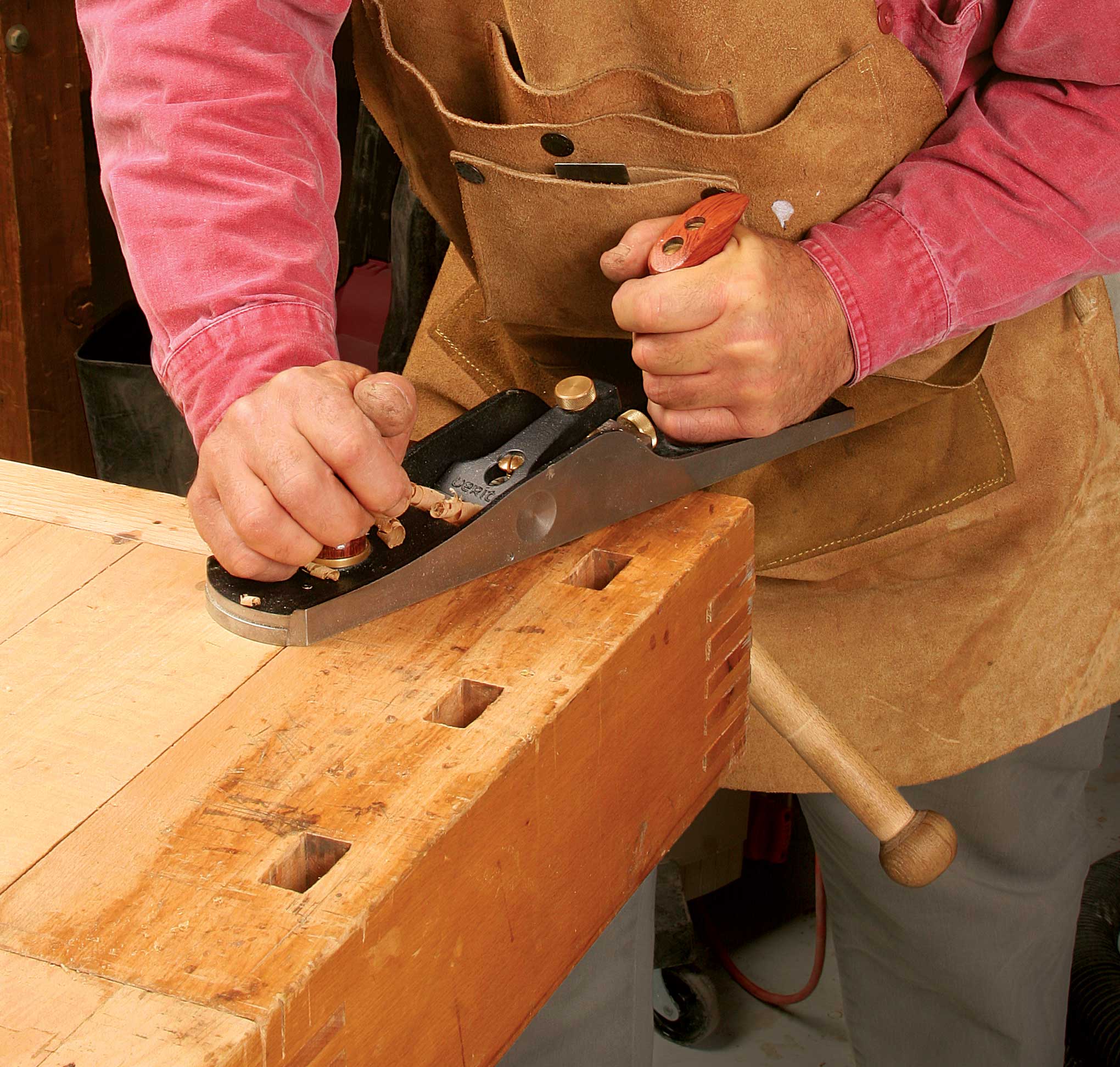
click to enlarge
Plane the top of the vise flush with that of the benchtop.
Sand and seal the benchtop
With the bench reassembled, very lightly sand the top smooth using P220-grit paper. To seal the benchtop, I use two coats of Zinsser’s Bull’s Eye amber shellac, thinned with three parts alcohol to one part shellac. I prefer shellac to a coat of oil because it seals the wood more thoroughly and reduces seasonal movement. Gently sand between each coat with P320-grit paper, apply some paste wax using 0000 steel wool, and buff the surface with a cotton cloth.

click to enlarge
Seal with shellac. A couple of coats of thinned shellac seal the benchtop better than oil.
When the bench is back in use, frequent light cleanups will keep any long-term wear in check. At the end of each day, when putting away tools and straightening up the shop, look over the bench for any glue or stain and clean it off. This step goes hand in hand with sharpening and maintaining all your other tools.
This article was excerpted from:

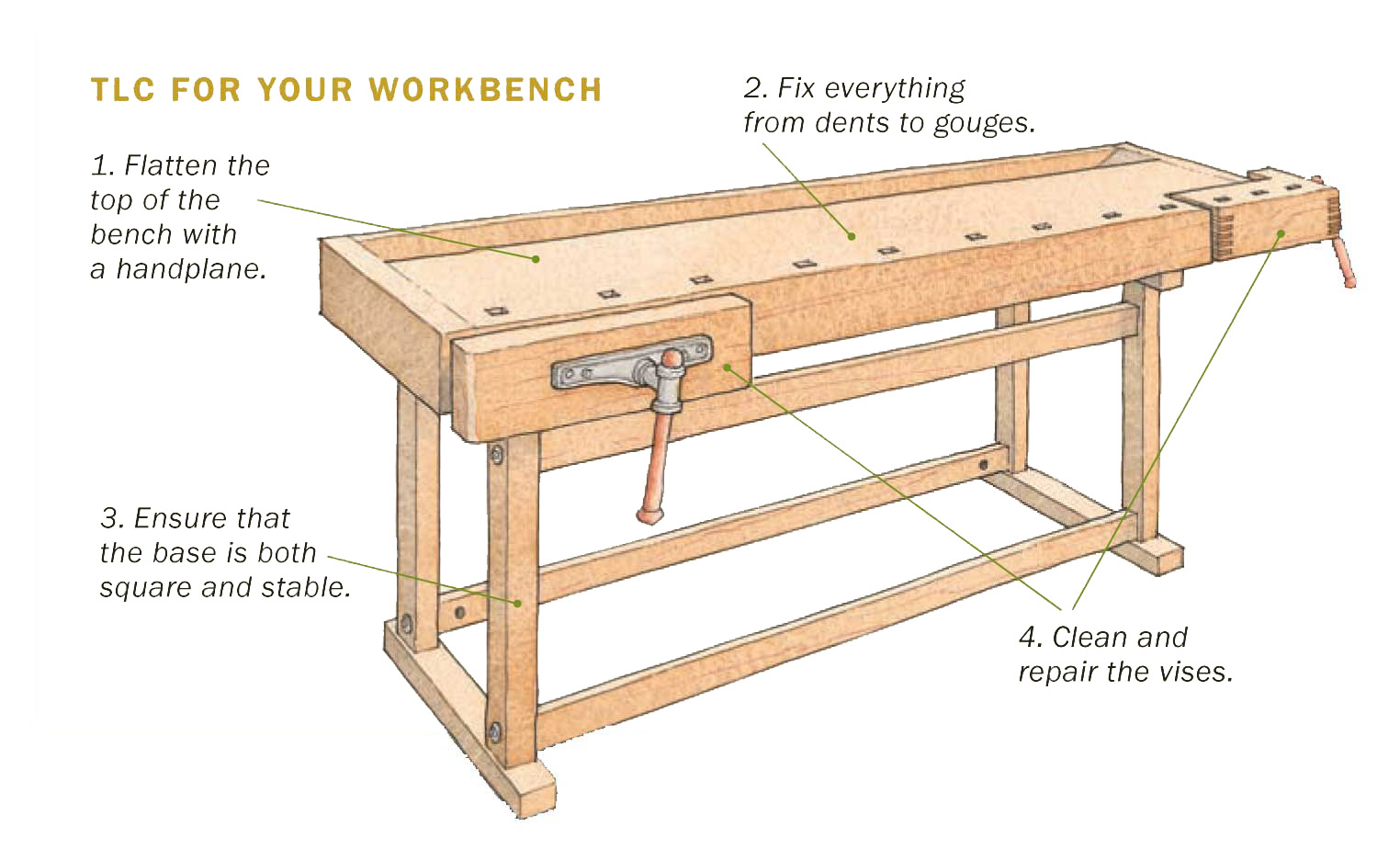
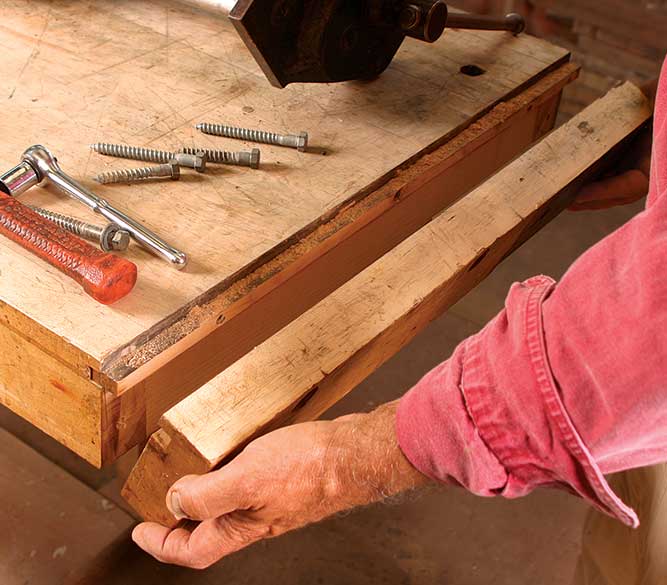

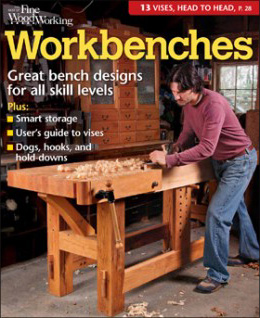





















Comments
I happen to be in the need for some replacement utility chisels, and I like the look of the ones shown in the picture regarding the Dutchman. I couldn't read the maker from the picture.
What brand are those, and to you like them (they hold an edge)?
Thanks,
Marty
Marty, looks like they may be the Lee Valley bench chisels (with plastic handles). They get dinged in reviews because they are too thick (or not beveled enough) for fine dovetail work. But they hold an edge well. I have gotten good use from mine even though I now have some finer chisels to detail work. Still use the LV chisels for much of my bench work.
I did not go back to the photo to verify, but at least you can check out the LV set(s).
On the subject of benches, dose any one know where the term bench Dog came from. Just asking Thanks
Jensen, "dog" is a widely used engineering term that refers to a device that prevents motion (via clamping or blocking) or allows motion by coupling. The "dog" part is because it bites and holds on.
almartin Thanks for the info. Some times I need a kick to the head. Thanks
@Marty, those are Stanley chisels (likely an older set). I found a set of the new Stanley FatMax chisels on sale quite cheap. Needing a set of "beater bench chisels", I picked them up, and have been very impressed with them. While no match for something like Lie-Nielsen, they're a very good set for the money. They take an edge quite nicely, and it holds up well too. They'll never get quite as sharp as a good O-1 chisel, as the steel isn't as finely grained, but they'll still shave hair off if well honed.
My good chisels are old Witherby chisels I picked up on Ebay and some James Swan's I've been picking up at local shops when I can find them. I'd recommend either brand, as they're forged from excellent steel and can be had for much less than L-N, especially if you're patient and don't mind a bit of hunting.
The link to Workbenches is broken.
When using a forstner bit to widen a hole, why put a square peg in? I realise chamfering is described but wouldn't dowel be better?
The enlarged image links are not working for me - Chrome on iPad.
Log in or create an account to post a comment.
Sign up Log in